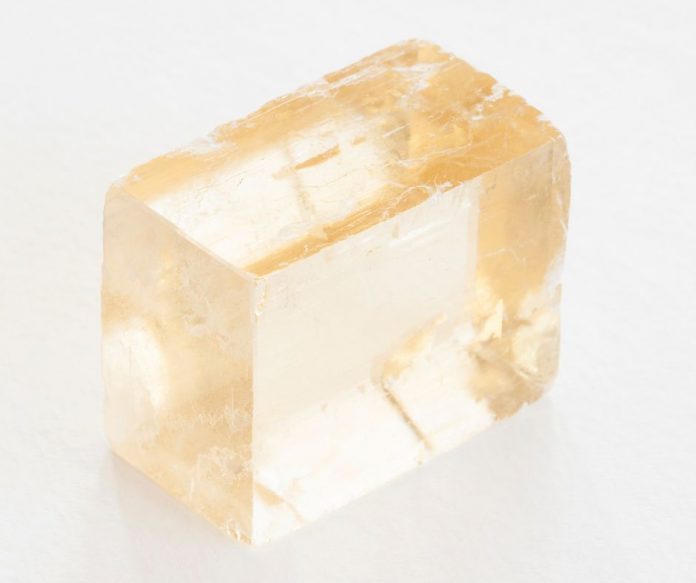
Calcite mineral properties make this a useful and magical stone. It is one of the most common minerals on earth. Usually white, calcite is a member of the carbonite mineral group and is found in a wide variety of localities and in fine colors which add to its popularity as a collector mineral. Limestone and marble are mainly calcite so it is one of the most common minerals for sheer volume and quantity. Double-refracting calcite was used in the Norden bomb site in World War II.
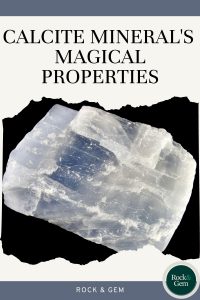
It is found in over 300 different, sometimes complex, crystal forms including double-refracting calcite. It offers collectors a shelf full of beautiful crystal forms from simple hexagons to butterfly twins, scalenohedrons, rhombs and a massive banded monochromatic alabaster that has been used for millennia.
A Calcite Properties Mystery
How did the ancient Vikings cross the north Atlantic Ocean out of sight of land on cloudy days and determine directions accurately for weeks without a compass? Can a magical property of calcite solve this question?
As early as the 800s A.D., the Vikings were sailing west for many days out of sight of land as they crossed the Atlantic and found Iceland. Granted the Chinese had developed the magnetic compass as early as 800 B.C. and maybe earlier. But, their magnetic compass did not reach Europe and the West until just before 1200 A.D.
The Vikings were already experienced sailors using the sun to stay on course. But what about those days, sometimes weeks, in the North Atlantic when the sky was densely overcast and the sun only a memory? In extreme northern Europe or Asia, summer nights experience prolonged periods of twilight after the sun has set. Viking sailors had to deal with this phenomenon yet could sail west accurately. How? The answer seems to be the Vikings solved the mystery of navigating without a compass by using double-refracting Iceland spar to find the sun and determine direction.
Double Refracting Iceland Spar
To understand double refracting Iceland spar we get into such science terms as refractive index, polarization and birefringence.
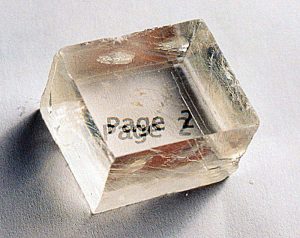
Private collection
We already know when you look at a single letter or line through a clear rhomb of Iceland spar you see a double image. This is because light is not organized as it travels randomly in waves of different lengths and directions. What Iceland spar does is organize or polarize the light waves so they are in two linear groups that move in slightly diverging directions so the image is doubled. One of the images may be a bit stronger than the other. In crystallography, we organize or polarize light passing into an unknown mineral and call it birefringence. Each mineral differs in polarizing light or birefringence so we use it to identify minerals.
But how can the polarizing birefringence property of Iceland spar be used to locate the sun when the sun is not visible? Despite being overcast, the sun’s unseen light rays do come through. Only an eclipse of the sun by the moon can make the earth’s atmosphere dark.
What the Vikings learned is that if you scan a piece of Iceland spar across the sky the source of light rays, the sun, will pass into and through the Iceland spar as two organized light rays. These show up giving you the sun’s position.
Tests have shown the Iceland spar method will identify the sun’s position within four degrees of its actual position. That’s close enough to serve as a navigation guide. The Vikings referred to a “sunstone” in their lore and stories. Could it be Iceland spar?
Iceland Spar Today
Do we have any uses for Iceland spar today? Of course. During World War II, the most accurate bombsight we had used the polarizing properties of Iceland spar for more accurate bomb aiming.
Though Iceland spar may seem mysterious, there is nothing mysterious about the beauty and great variety of well-crystallized calcite. Iceland spar is most often seen as a rhombic cleavage, not a crystal. When a calcite crystal is shattered every little piece takes on the same rhombic shape. It was this property of calcite that helped French scientist Rene Just Hauy in his establishment of the Science of Crystallography.
Calcite Forms
Calcite, like all other minerals, falls in one of the six crystal systems: cubic, monoclinic, triclinic, orthorhombic, tetragonal and hexagonal. Of these, calcite was assigned to the hexagonal system. As scientists delved deeper into these systems they realized there were problems with the hexagonal system, especially with calcite.
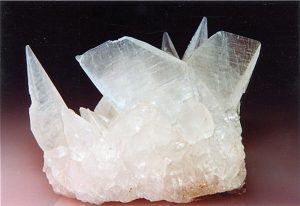
Jones collection
Many calcite crystals exhibit the classic six-sided crystal, clearly hexagonal. Yet calcite commonly exhibits a different crystal form, a rhombohedron. Calcite crystals from Tsumeb and Iceland show this form. Scientists realized internally some calcite crystals had six internal axes that formed the hexagon.
Some calcites only had three axes and their crystals reflected this. A subdivision was added to the crystal system, trigonal. Some list this as a seventh system while others pair it up with hexagon within the hexagonal system. Calcite may be hexagon or trigonal.
Does this mean calcite is being mysterious again or is there a simple explanation? Scientists figured it out. It is the stability of the calcite during crystal growth that influences what grows. Differences in temperature and pressure affect calcite’s crystal form. The different forms of calcite are determined by the environment and stability and can be charted. The known crystal forms of calcite are placed on a sliding scale of increasing or decreasing temperature and pressure. This is charted on page 534 in Ivan Kostov’s superb book “Mineralogy” published by Oliver and Lord, London, 1968. The chart shows the effect of temperature on calcite crystal forms.
Calcite Mineral Today
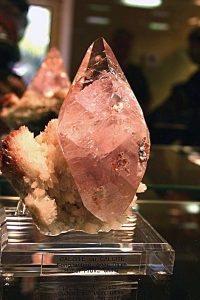
Calcite is still one of the more popular collector minerals. New sources, like mines in China, have yielded amazing specimens including intensely pink crystals. Some collectors specialize in this calcium carbonate.
The role minerals have played in the movement of people around the world is well known. Gold rushes, the search for diamonds, the prospecting for uranium and other minerals are still with us. Yet, of all these important movements and migrations, it is significant that a simple calcite rhomb could be responsible for the Vikings navigating the open oceans and discovering the New World. Calcite should take its place among the more important minerals in the history of mankind.
This story about calcite mineral properties appeared in Rock & Gem magazine. Click here to subscribe. Story by Bob Jones.















